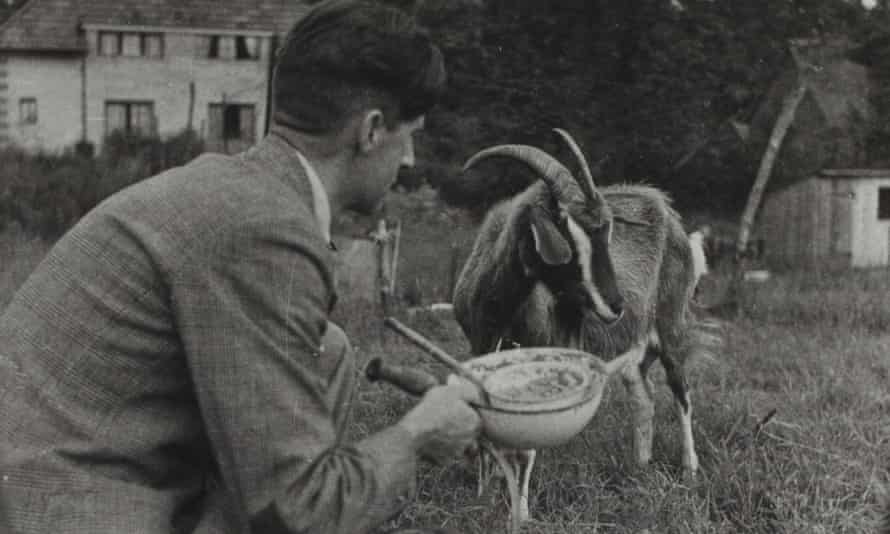‘Every time you commit an antisocial act, push an acorn into the ground’: Rebecca Solnit on Orwell’s lessons from nature
When the American writer went in search of trees and roses planted by George Orwell in a Hertfordshire garden, she uncovered questions of legacy and peace

In the spring of 1936 a writer planted roses. I had known this for more than three decades and never thought enough about what that meant until a November day a few years ago, when I was under doctor’s orders to recuperate at home in San Francisco but was actually on a train from London to Cambridge to talk with another writer about a book I’d written. It was 2 November, and where I’m from that’s celebrated as Dia de Muertos (the Day of the Dead). Back home, my neighbours had built altars to those who had died in the past year, decorated with candles, food, marigolds, photographs of and letters to those they’d lost, and in the evening people were going to promenade and fill the streets to pay their respects at the open-air altars and eat pan de muerto (bread of death), some of their faces painted to look like skulls adorned with flowers in that Mexican tradition that finds life in death and death in life.
But I was on a morning train rolling north from King’s Cross in London. I was looking for some trees – perhaps a Cox’s orange pippin apple tree and some other fruit trees – for Sam Green, who’s a documentary film-maker and one of my closest friends. He and I had been talking about trees, and more often emailing about them, for several years.

Sam had found solace and joy in trees in the hard year after his younger brother died in 2009, and I think we both loved the sense of steadfast continuity a tree can represent. I had grown up in a rolling California landscape studded with several kinds of oak tree along with bays and buckeyes. Many individual trees that I knew as a child are still recognisable when I return, so little changed when I have changed so much. At the other end of the county was Muir Woods, the famous redwood forest of old-growth trees left uncut when the rest of the area was logged.
Slices of redwood trees a dozen or more feet across, with their annual rings used as history charts, were popular in my youth, and the arrival of Columbus in the Americas or the signing of Magna Carta and sometimes the birth and death of Jesus would be marked on the huge discs in museums and parks. The oldest redwood in Muir Woods is 1,200 years old, so more than half its time on Earth had passed before the first Europeans showed up in what they would name California. A tree planted tomorrow that lived as long would be standing in the 33rd century AD, and it would be short-lived compared with the bristlecones a few hundred miles east, which can live up to 5,000 years. Trees are an invitation to think about time and to travel in it the way they do, by standing still and reaching out and down.
If war has an opposite, gardens may sometimes be it, and people have found a particular kind of peace in forests, meadows, parks and gardens. The surrealist artist Man Ray fled Europe and the Nazis in 1940 and spent the next decade in California. During the second world war, he visited the sequoia groves in the Sierra Nevada and wrote of these trees that are broader than redwoods, but not quite as tall. “They are the oldest living things in nature, going back to Egyptian antiquity, their warm-coloured, tender bark seems soft as flesh. Their silence is more eloquent than the roaring torrents and Niagaras, than the reverberating thunder in Grand Canyon, than the bursting of bombs; and is without menace.”
There’s an Etruscan word, saeculum, that describes the span of time lived by the oldest person present, sometimes calculated to be about 100 years. In a looser sense, the word means the expanse of time during which something is in living memory. Every event has its saeculum, and then its sunset when the last person who fought in the Spanish civil war or the last person who saw the last passenger pigeon is gone. To us, trees seemed to offer another kind of saeculum, a longer timescale and deeper continuity, giving shelter from our ephemerality the way that a tree might offer literal shelter under its boughs.
The summer before my trip to England, when Sam and I were hanging out at my home talking about trees, I had mentioned an essay by George Orwell I had loved for a long time; a brief, casual, lyrical piece he dashed off in the spring of 1946 for his As I Please column in Tribune, the socialist weekly where he published about 80 pieces from 1943 to 1947. The essay that appeared on 26 April 1946 is titled A Good Word for the Vicar of Bray, and it’s a triumph of meandering that begins by describing a yew tree in a Berkshire churchyard said to have been planted by a vicar who was a famously fickle political player, switching sides repeatedly in the religious wars of the time. That fickleness let him survive and stay in place, like a tree, while many fell or fled.
Orwell writes of the vicar: “Yet, after this lapse of time, all that is left of him is a comic song and a beautiful tree, which has rested the eyes of generation after generation and must surely have outweighed any bad effects which he produced by his political quislingism.” From there, Orwell leapt to the last king of Burma, whose supposed misdeeds he mentioned, along with the trees that king planted in Mandalay, “tamarind trees which cast a pleasant shade until the Japanese incendiary bombs burned them down in 1942”. Orwell had been in the Indian Imperial Police in Burma, so he would have seen those trees for himself in the 1920s, as well as the huge yew he described in the church cemetery in Bray, a village west of London.
Quick GuideSaturday magazine Show

This article comes from Saturday, the new print magazine from the Guardian which combines the best features, culture, lifestyle and travel writing in one beautiful package. Available now in the UK and ROI.
Orwell proposes that “the planting of a tree, especially one of the long-living hardwood trees, is a gift which you can make to posterity at almost no cost and with almost no trouble, and if the tree takes root it will far outlive the visible effect of any of your other actions, good or evil”. And then he mentions the inexpensive roses and fruit trees he had planted himself, 10 years earlier, and how he had revisited them recently and in them beheld his own modest botanical contribution to posterity. “One of the fruit trees and one of the rose bushes died, but the rest are all flourishing. The sum total is five fruit trees, seven roses and two gooseberry bushes, all for 12 and sixpence. These plants have not entailed much work, and have had nothing spent on them beyond the original amount. They never even received any manure, except what I occasionally collected in a bucket when one of the farm horses happened to have halted outside the gate.”
I’d derived from that last line a picture of the author with a bucket and a gate beyond which horses passed, but I hadn’t thought more about where and how he lived at the time and why he planted roses. Nevertheless, I had found the essay memorable and moving from the time I first encountered it. I thought it was a fugitive trace of an Orwell that remained embryonic, undeveloped, of who he might have been in less violent times, but I was wrong about that.
His life was shot through with wars. He was born on 25 June 1903, right after the Boer war, reached adolescence during the first world war (a patriotic poem, written when he was 11, was his first published work), with the Russian revolution and the Irish war of independence raging into the 20s and the beginning of his adulthood, been among those who saw all through the 30s the conflagrations of the second world war being set up, who fought in the Spanish civil war in 1937, had lived in London during the blitz and been bombed out himself, and coined the term “cold war” in 1945; he saw that cold war and its nuclear arsenals grow more fearsome in the last years before his death on 21 January 1950. Those conflicts and menaces consumed a lot of his attention – but not all of it.
I had first read his essay on tree planting in a big, ugly, dog-eared paperback titled The Orwell Reader, which I bought cheap from a used bookstore when I was about 20 and wandered through for years, getting to know his style and tone as an essayist, his opinions about other writers, about politics, about language and writing – a book I had absorbed when I was young enough for it to be a foundational influence on my own meander towards becoming an essayist. I had come across his 1945 fable Animal Farm as a child, so that I first read it as a story about animals and mourned the faithful horse Boxer’s death and not known that it was an allegory for the corruption of the Russian revolution into Stalinism.

I’d read Nineteen Eighty-Four for the first time as a teenager, and then got to know Homage to Catalonia, his first-hand account of the Spanish civil war, in my 20s. That last book had been a major influence on my second book, Savage Dreams, for its example of honesty about the shortcomings of one’s own side and loyalty to it anyway and of how to incorporate into a political narrative personal experience all the way down to doubts and discomforts – that is, how to make room for the small and subjective inside something big and historic. He had been one of my principal literary influences, but I had not got to know more about him than what he revealed in the books and whatever set of assumptions was ambient.
That essay of his I shared with Sam was in praise of the arboreal saeculum, and it was hopeful in that it looked to the future as something we could contribute to and, more than that, in that year after the first atom bombs had been detonated, as something we could have some degree of faith in: “Even an apple tree is liable to live for about 100 years, so that the Cox I planted in 1936 may still be bearing fruit well into the 21st century. An oak or a beech may live for hundreds of years and be a pleasure to thousands or tens of thousands of people before it is finally sawn up into timber. I am not suggesting that one can discharge all one’s obligations towards society by means of a private re-afforestation scheme. Still, it might not be a bad idea, every time you commit an antisocial act, to make a note of it in your diary, and then, at the appropriate season, push an acorn into the ground.” The essay took a tone common in his work, travelling nonchalantly from particulars to generalities, and from the minor to the major – in this case from one particular apple tree to universal questions of redemption and legacies.
That summer day when we fell to talking about trees, I told Sam about Orwell’s garden, and he grew excited, and we went over to my computer to see if we could find out if the five fruit trees were still there. It took only a few minutes to dig up the address of the cottage Orwell had moved to in April 1936 and then a minute or two more to zoom in on the address on a mapping app, but the aerial views were full of indistinct blobs of green foliage that didn’t tell us what we wanted to know.
Sam wrote a letter to the inhabitants of the address we’d found. It was a very Sam letter that noted that “we are not kooks”, but people who had a respectable history of taking interest in obscure facts and researching historical tangents. We hadn’t heard back when I stepped off the train in Baldock in Hertfordshire, several stops before Cambridge, a little wobbly, a little anxious about knocking on that cottage door, but also more than a little exhilarated.
It only took a few minutes by taxi to reach the village of Wallington, where the taxi driver saw a man outside and said: “Oh there’s Graham now, I’ll just introduce you.” I had thought it likely I would be rebuffed or reproached, but Graham Lamb – a slight older man with curling gray hair and, also, a Scottish accent – was cheerful and welcoming, and I was ushered into the back and introduced to Dawn, his partner, who was working in the garden.
Dawn had come across the place when it was up for sale a few years earlier and they bought it immediately. The fruit trees were no more, cut down in the 1990s when the garden shed in the back had been expanded, but
the roses Orwell planted were still there. The news startled me into alertness. Even on that November day two big unruly rosebushes were in bloom, one with pale pink buds opening up a little and another with almost salmon flowers with a golden-yellow rim at the base of each petal. They were exuberantly alive, these allegedly octogenarian roses, living things planted by the living hand (and shovel work) of someone gone for most of their lifetime. Graham told me that the roses were so prolific that the schoolmistress, Miss Brookes, who had bought the cottage in 1948 after Orwell surrendered the lease, used buds from one of them as tickets for admission for the village fete. In 1983, she reported that the Albertine rose he planted was “the glory of the garden” and “still blooms”.
His roses had been blooming in November 1939, as Orwell noted in his domestic diary: “Roses still attempting to flower, otherwise no flowers in the garden now.” Nearly everyone who knew him is gone, but the roses are a sort of saeculum that includes Orwell. I was suddenly in his presence in a way I hadn’t expected, and I was in the presence of a living remnant of the essay, and they rearranged my old assumptions.
The directness of these two plants’ connection to him and to that long-ago essay about roses and fruit trees and continuity and posterity filled me with joyous exaltation. So did the fact that this man, most famous for his prescient scrutiny of totalitarianism and propaganda, for facing unpleasant facts, for a spare prose style and an unyielding political vision, had planted roses. That a socialist or a utilitarian or any pragmatist or practical person might plant fruit trees is not surprising: they have tangible economic value and produce the necessary good that is food even if they produce more than that. But to plant a rose – or in the case of this garden he resuscitated in 1936, seven roses early on and more later – can mean so many things.
I had not thought hard enough about those roses I had first read about more than a third of a century before. They were roses, and they were saboteurs of my own long acceptance of a conventional version of Orwell and invitations to dig deeper. They were questions about who he was and who we were and where pleasure and beauty and hours with no quantifiable practical result fit into the life of someone, perhaps of anyone, who also cared about justice and truth and human rights and how to change the world.
This is an edited extract from Orwell’s Roses by Rebecca Solnit, published by Granta on 21 October. To support the Guardian and the Observer buy a copy at guardianbookshop.com. Delivery charges may apply